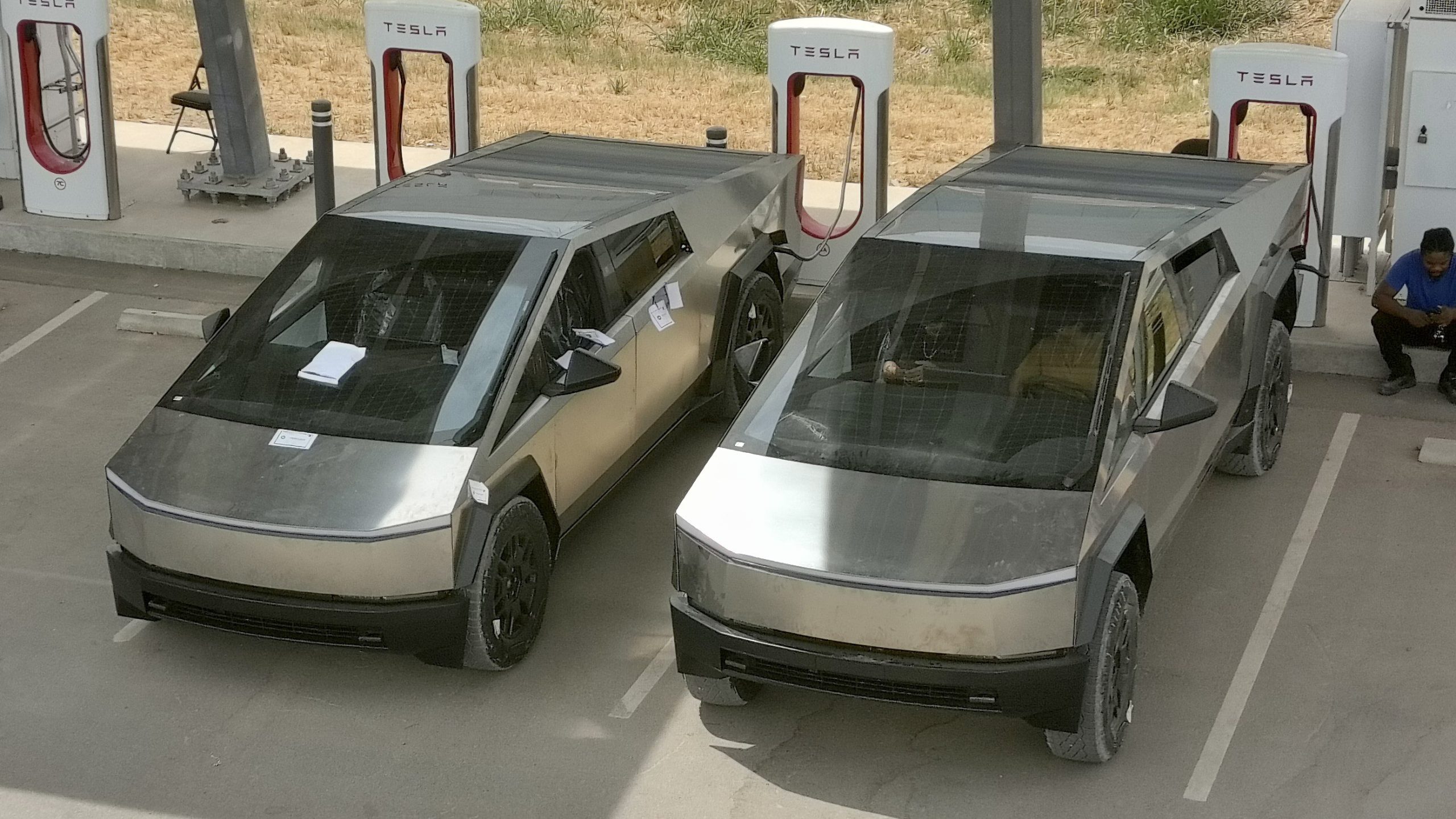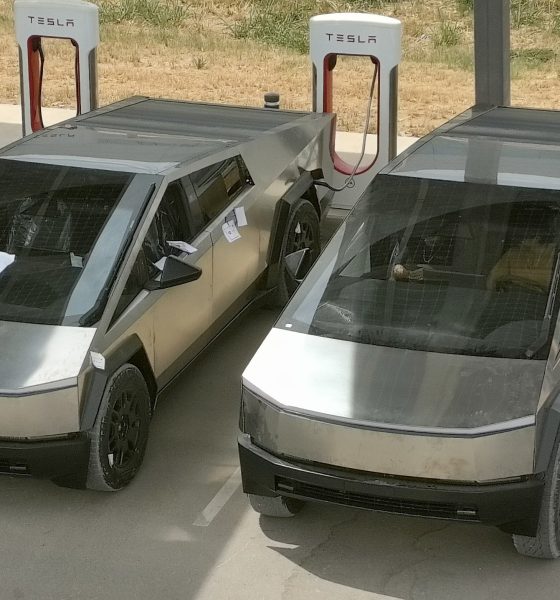

News
Tesla Cybertruck will equip 800v architecture for faster charging times, better margins
Tesla Cybertruck will equip an 800-volt architecture when it begins deliveries on November 30, an announcement that is still fresh from the company’s Earnings Call earlier this week.
For EV newbies, the 800-volt architecture may not be much of a head-turner. However, to those who have been following the industry at all, 800v architectures are the way of the future for the EV industry, especially as more electric cars are on the road, charging times continue to be a concern to some, and heavier all-electric cars are becoming more available throughout the various automakers.
On Wednesday, Tesla confirmed what many believed for a long time: the Cybertruck would equip an 800-volt architecture.
What are the strengths of an 800-volt architecture? It comes down to charging times, efficiency, margins, and weight, all things that are important to the company and its products, as well as its financial status.
Tesla Cybertruck and Semi are candidates for 800-volt architecture
From a macro standpoint, Tesla’s financials are still strong. But Musk and Co. were not shy about warning investors and analysts about the upcoming economic headwinds it would encounter.
It’s a market-wide issue and not just a Tesla issue. As Tesla plans to launch the Cybertruck, interest rates are high, discouraging consumers from wanting to finance anything. Additionally, Musk confirmed it may take 18 months for the Cybertruck to be a positive cash flow contributor to Tesla’s financials.
The 800-volt architecture will improve margins on the vehicle instead of other EV architectures that may have been considered. It said explicitly in its Q3 Shareholder Deck:
“For very heavy vehicles, a high voltage powertrain architecture brings notable cost savings, which is why Cybertruck will adopt an 800-volt architecture.”
From a cost perspective, 800-volt architectures are void of as much copper throughout the vehicle, which reduces weight. Weight reductions improve performance and range.
Earlier today, we reported on the Cybertruck VIN Decoder, which was released by the NHTSA. It revealed the Cybertruck has two weight classifications:
“…the vehicle’s gross weight has two classes: G, which would be between 8,001 and 9,000 pounds, and H, which is between 9,001 and 10,000 pounds.”
800-volt architectures have greater efficiency because they allow electricity to move from the battery to the wheels with a lower current. This ultimately reduces the amount of power that is lost to heat, and higher voltage – lower current architectures can move the same amount of power with thinner wires, which relates to the reduction in copper that was mentioned previously.
800-volt architectures are big for the future of EVs, even outside of Teslas. Tesla EVs are far from the first cars on the market to equip an 800-volt architecture, as the Porsche Taycan had an 800v build back in 2018 when the German company unveiled the specs for its introductory EV.
Faster charging is the biggest advantage, as they can handle greater outputs from Superchargers. The V4 Supercharger from Tesla, for example, has a 350 kW output, enabled by increased amperage and current ratings.
This will keep EV owners at the Superchargers for less time, making charging more efficient and allowing more people to access chargers by decreasing congestion.
I’d love to hear from you! If you have any comments, concerns, or questions, please email me at joey@teslarati.com. You can also reach me on Twitter @KlenderJoey, or if you have news tips, you can email us at tips@teslarati.com.

News
Tesla FSD fleet is nearing 7 billion total miles, including 2.5 billion city miles
As can be seen on Tesla’s official FSD webpage, vehicles equipped with the system have now navigated over 6.99 billion miles.

Tesla’s Full Self-Driving (Supervised) fleet is closing in on almost 7 billion total miles driven, as per data posted by the company on its official FSD webpage.
These figures hint at the massive scale of data fueling Tesla’s rapid FSD improvements, which have been quite notable as of late.
FSD mileage milestones
As can be seen on Tesla’s official FSD webpage, vehicles equipped with the system have now navigated over 6.99 billion miles. Tesla owner and avid FSD tester Whole Mars Catalog also shared a screenshot indicating that from the nearly 7 billion miles traveled by the FSD fleet, more than 2.5 billion miles were driven inside cities.
City miles are particularly valuable for complex urban scenarios like unprotected turns, pedestrian interactions, and traffic lights. This is also the difference-maker for FSD, as only complex solutions, such as Waymo’s self-driving taxis, operate similarly on inner-city streets. And even then, incidents such as the San Francisco blackouts have proven challenging for sensor-rich vehicles like Waymos.
Tesla’s data edge
Tesla has a number of advantages in the autonomous vehicle sector, one of which is the size of its fleet and the number of vehicles training FSD on real-world roads. Tesla’s nearly 7 billion FSD miles then allow the company to roll out updates that make its vehicles behave like they are being driven by experienced drivers, even if they are operating on their own.
So notable are Tesla’s improvements to FSD that NVIDIA Director of Robotics Jim Fan, after experiencing FSD v14, noted that the system is the first AI that passes what he described as a “Physical Turing Test.”
“Despite knowing exactly how robot learning works, I still find it magical watching the steering wheel turn by itself. First it feels surreal, next it becomes routine. Then, like the smartphone, taking it away actively hurts. This is how humanity gets rewired and glued to god-like technologies,” Fan wrote in a post on X.
News
Tesla starts showing how FSD will change lives in Europe
Local officials tested the system on narrow country roads and were impressed by FSD’s smooth, human-like driving, with some calling the service a game-changer for everyday life in areas that are far from urban centers.

Tesla has launched Europe’s first public shuttle service using Full Self-Driving (Supervised) in the rural Eifelkreis Bitburg-Prüm region of Germany, demonstrating how the technology can restore independence and mobility for people who struggle with limited transport options.
Local officials tested the system on narrow country roads and were impressed by FSD’s smooth, human-like driving, with some calling the service a game-changer for everyday life in areas that are far from urban centers.
Officials see real impact on rural residents
Arzfeld Mayor Johannes Kuhl and District Administrator Andreas Kruppert personally tested the Tesla shuttle service. This allowed them to see just how well FSD navigated winding lanes and rural roads confidently. Kruppert said, “Autonomous driving sounds like science fiction to many, but we simply see here that it works totally well in rural regions too.” Kuhl, for his part, also noted that FSD “feels like a very experienced driver.”
The pilot complements the area’s “Citizen Bus” program, which provides on-demand rides for elderly residents who can no longer drive themselves. Tesla Europe shared a video of a demonstration of the service, highlighting how FSD gives people their freedom back, even in places where public transport is not as prevalent.
What the Ministry for Economic Affairs and Transport says
Rhineland-Palatinate’s Minister Daniela Schmitt supported the project, praising the collaboration that made this “first of its kind in Europe” possible. As per the ministry, the rural rollout for the service shows FSD’s potential beyond major cities, and it delivers tangible benefits like grocery runs, doctor visits, and social connections for isolated residents.
“Reliable and flexible mobility is especially vital in rural areas. With the launch of a shuttle service using self-driving vehicles (FSD supervised) by Tesla in the Eifelkreis Bitburg-Prüm, an innovative pilot project is now getting underway that complements local community bus services. It is the first project of its kind in Europe.
“The result is a real gain for rural mobility: greater accessibility, more flexibility and tangible benefits for everyday life. A strong signal for innovation, cooperation and future-oriented mobility beyond urban centers,” the ministry wrote in a LinkedIn post.
News
Tesla China quietly posts Robotaxi-related job listing
Tesla China is currently seeking a Low Voltage Electrical Engineer to work on circuit board design for the company’s autonomous vehicles.

Tesla has posted a new job listing in Shanghai explicitly tied to its Robotaxi program, fueling speculation that the company is preparing to launch its dedicated autonomous ride-hailing service in China.
As noted in the listing, Tesla China is currently seeking a Low Voltage Electrical Engineer to work on circuit board design for the company’s autonomous vehicles.
Robotaxi-specific role
The listing, which was shared on social media platform X by industry watcher @tslaming, suggested that Tesla China is looking to fill the role urgently. The job listing itself specifically mentions that the person hired for the role will be working on the Low Voltage Hardware team, which would design the circuit boards that would serve as the nervous system of the Robotaxi.
Key tasks for the role, as indicated in the job listing, include collaboration with PCB layout, firmware, mechanical, program management, and validation teams, among other responsibilities. The role is based in Shanghai.
China Robotaxi launch
China represents a massive potential market for robotaxis, with its dense urban centers and supportive policies in select cities. Tesla has limited permission to roll out FSD in the country, though despite this, its vehicles have been hailed as among the best in the market when it comes to autonomous features. So far, at least, it appears that China supports Tesla’s FSD and Robotaxi rollout.
This was hinted at in November, when Tesla brought the Cybercab to the 8th China International Import Expo (CIIE) in Shanghai, marking the first time that the autonomous two-seater was brought to the Asia-Pacific region. The vehicle, despite not having a release date in China, received a significant amount of interest among the event’s attendees.








